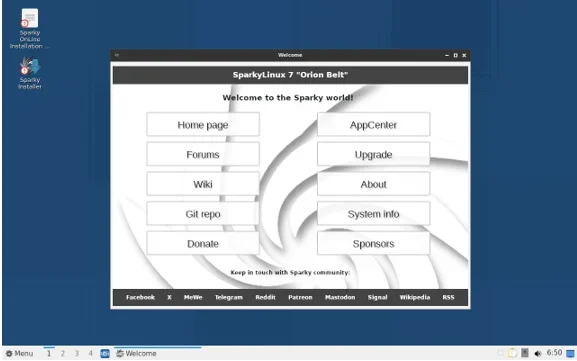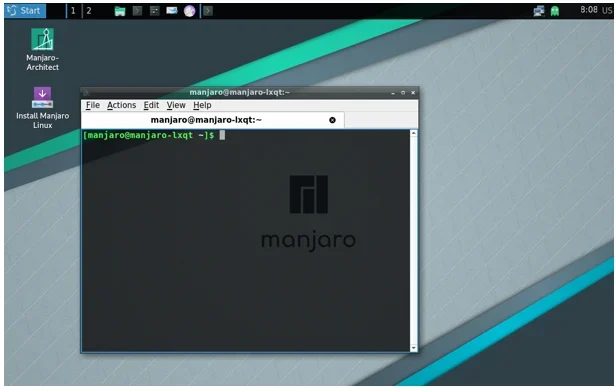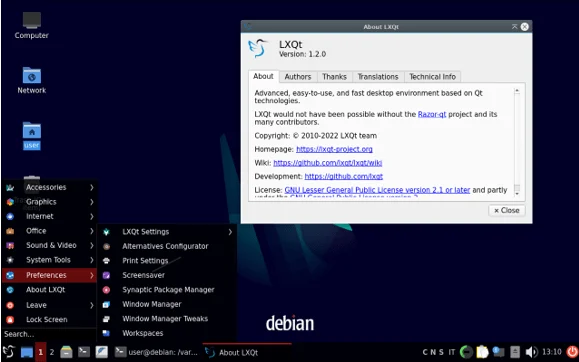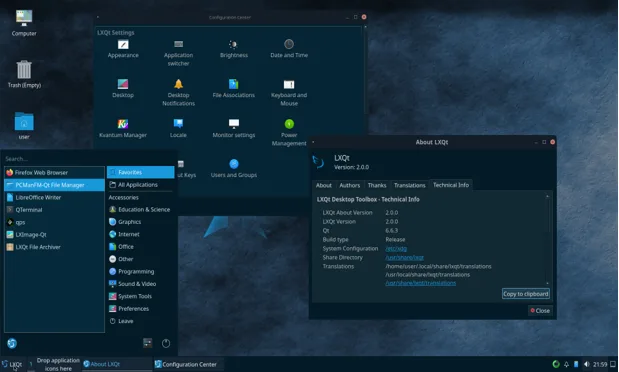If you’re a Linux enthusiast looking for a lightweight yet modern desktop environment, LXQt is a name that likely rings a bell. Known for its speed, efficiency, and modular design, LXQt is a Qt-based desktop environment that delivers a traditional desktop experience without taxing your system’s resources. For those running older hardware or simply seeking a snappy, customizable interface, LXQt-based Linux distributions are an excellent choice.
In this in-depth guide, we’ll explore the best LXQt Linux distros you should try in 2025, diving into their features, system requirements, and why they stand out for knowledgeable users. Whether you’re a power user, a developer, or someone looking to revive an aging PC, this post has you covered.
What is LXQt, and Why Choose It?
Before we dive into the distros, let’s quickly unpack what makes LXQt special. LXQt is a lightweight desktop environment born from the merger of LXDE (Lightweight X11 Desktop Environment) and Razor-qt projects. Unlike its GTK-based predecessor LXDE, LXQt leverages the Qt framework, offering a modern look and feel while remaining resource-efficient. It’s designed for users who want a balance between performance and functionality, making it ideal for low-spec machines or those who prioritize speed.
Key features of LXQt include
- Modularity: LXQt doesn’t bundle its own window manager, allowing users to choose from options like Openbox, Xfwm4, or KWin.
- Low Resource Usage: It’s significantly lighter than heavier environments like GNOME or KDE Plasma, making it perfect for older hardware.
- Customizability: LXQt offers a traditional desktop paradigm with extensive configuration options for power users.
- Modern Aesthetics: Despite its lightweight nature, LXQt provides a polished and visually appealing interface.
For knowledgeable readers, LXQt’s appeal lies in its ability to deliver a no-frills, performance-oriented desktop that doesn’t sacrifice usability. Its compatibility with various window managers and minimal system requirements make it a go-to choice for custom setups. Now, let’s explore the top LXQt-based Linux distributions for 2025, curated based on official data, community feedback, and real-world performance.
1. Lubuntu: The Ubuntu-Powered Lightweight Champion
Why Choose Lubuntu?
Lubuntu is arguably the most well-known LXQt-based distro, and for good reason. As an official Ubuntu flavor, Lubuntu combines the stability and vast software ecosystem of Ubuntu with the lightweight LXQt desktop environment. It’s a fantastic choice for users transitioning from Windows or macOS, as well as those with older hardware looking for a modern, supported OS.

Key Features:
- Ubuntu Repositories: Access thousands of packages via Ubuntu’s extensive software repositories, ensuring you’re never short on tools or apps.
- Long-Term Support (LTS): Lubuntu offers LTS releases (e.g., 24.04 LTS) with five years of support, ideal for users prioritizing stability.
- Beginner-Friendly: Lubuntu’s “Discover” Software Center and pre-installed apps like Firefox, VLC, and LibreOffice make it approachable for newcomers.
- System Requirements: Runs smoothly on systems with as little as 1GB of RAM and a 1GHz processor, though 2GB RAM is recommended for optimal performance.
Who It’s For: Lubuntu is perfect for users who want a lightweight, stable, and well-supported distro with a familiar desktop experience. It’s especially suited for reviving old PCs or laptops, as its minimal resource usage ensures snappy performance. Power users will appreciate the ability to customize LXQt with their preferred window manager, such as Openbox (Lubuntu’s default).
Notable Updates in 2025: Lubuntu 24.04 LTS, released in April 2024, remains a cornerstone in 2025, with ongoing updates to the LXQt desktop (version 2.0 as of late 2024). The distro continues to refine its integration with Snap packages, though some users may prefer traditional .deb packages for a leaner system. Check the official Lubuntu website for the latest ISOs and release notes.
Pros:
- Backed by Canonical’s robust infrastructure.
- Extensive community support and documentation.
- Ideal for both new and experienced users.
Cons:
- Snap packages can increase resource usage over time.
- LXQt’s interface may feel basic compared to GNOME or KDE for users with high-performance machines.
2. SparkyLinux: The Debian-Based Speed Demon
Why Choose SparkyLinux?
SparkyLinux is a lightweight, Debian-based distro that offers an LXQt edition among other desktop environments. Known for its speed and flexibility, SparkyLinux caters to users who want a fast, customizable OS with access to Debian’s vast package ecosystem. Its rolling release model (in the testing branch) ensures you’re always on the latest software, while the stable branch offers rock-solid reliability.

Key Features:
- Debian Base: Choose between Debian’s stable or testing branches, depending on your preference for stability or cutting-edge updates.
- LXQt Edition: The LXQt version is optimized for low-resource systems, with minimal bloat and a clean interface.
- APtus Tool: Sparky’s custom tool simplifies system administration, package management, and desktop customization.
- System Requirements: Can run on systems with 512MB of RAM, though 1GB is recommended for a smoother experience.
Who It’s For: SparkyLinux is ideal for advanced users who want a lightweight, Debian-based distro with the flexibility to tailor their system. Its rolling release option appeals to those who prefer the latest software, while the stable branch suits users needing long-term reliability. The LXQt edition is perfect for older hardware or minimalistic setups.
Notable Updates in 2025: SparkyLinux continues to release regular updates, with the LXQt edition benefiting from the latest Debian packages and LXQt 2.2 (expected in mid-2025). The distro’s focus on performance makes it a favorite among power users who enjoy tweaking their systems. Visit the official SparkyLinux website for downloads and documentation.
Pros:
- Lightweight and highly customizable.
- Rolling release option for bleeding-edge updates.
- Strong community and active development.
Cons:
- Rolling releases may introduce occasional instability.
- Less beginner-friendly than Lubuntu.
3. Manjaro LXQt: The User-Friendly Arch-Based Option
Why Choose Manjaro LXQt?
Manjaro is a user-friendly, Arch-based Linux distribution that offers an LXQt edition for those seeking a lightweight yet modern desktop experience. Unlike pure Arch Linux, Manjaro simplifies the installation process and comes with a pre-configured LXQt desktop, making it accessible to both new and experienced users. Its rolling-release model ensures you stay on the latest software, including the newest LXQt versions.

Key Features:
- Arch-Based Rolling Release: Access the latest packages from Arch’s repositories, with Manjaro’s curation for added stability.
- User-Friendly Installer: Manjaro’s Calamares installer makes setup straightforward, even for users new to Arch-based systems.
- Pre-Configured LXQt: Comes with a polished LXQt desktop, lightweight apps, and sensible defaults for immediate usability.
- System Requirements: Runs on systems with 1GB of RAM and a 1GHz processor, though 2GB RAM is recommended for optimal performance.
Who It’s For: Manjaro LXQt is ideal for users who want the benefits of Arch Linux (latest software, flexibility) without the complex setup. It’s a great choice for those transitioning from heavier distros or looking for a lightweight, modern system that’s easy to install and maintain. Its balance of simplicity and power makes it suitable for both beginners and power users.
Notable Updates in 2025: Manjaro’s LXQt edition continues to receive regular updates, with LXQt 2.2 expected in mid-2025. The distro benefits from Manjaro’s curated package management, which delays Arch updates slightly to ensure stability. Visit the official Manjaro website for downloads and community forums.
Pros:
- Easy to install compared to pure Arch.
- Rolling release with curated updates for stability.
- Polished LXQt desktop out of the box.
Cons:
- Slightly heavier than minimal distros like SparkyLinux or antiX.
- Rolling releases may occasionally introduce bugs.
4. Debian with LXQt: The Universal Choice for Power Users
Why Choose Debian with LXQt?
Debian is the foundation for many Linux distros, including Ubuntu and SparkyLinux, and offers an LXQt edition for users who want a stable, versatile, and highly customizable system. While not a standalone “LXQt distro” like Lubuntu, Debian’s LXQt variant is a powerhouse for knowledgeable users who prefer to build their system from the ground up.

Key Features:
- Rock-Solid Stability: Debian’s stable branch is renowned for its reliability, making it ideal for servers and long-term deployments.
- Extensive Package Repository: Access thousands of packages via Debian’s APT system, with support for multiple architectures.
- Customizable LXQt Setup: Choose your preferred window manager (e.g., Xfwm4) and configure LXQt to your liking.
- System Requirements: Can run on systems with 512MB of RAM, though 1GB or more is recommended for multitasking.
Who It’s For: Debian with LXQt is best for advanced users who want complete control over their system. It’s ideal for those comfortable with manual configuration and command-line tools, as well as users running older hardware or servers. Its stability makes it a top choice for mission-critical setups.
Notable Updates in 2025: Debian 12 “Bookworm” (released in 2023) remains the stable branch in 2025, with LXQt 0.17 or newer included. The upcoming Debian 13 “Trixie” (expected in mid-2025) will bring newer LXQt versions and improved hardware support. Visit the official Debian website for installation guides and ISOs.
Pros:
- Unmatched stability and reliability.
- Highly customizable and versatile.
- Supports a wide range of hardware.
Cons:
- Requires more technical expertise than Lubuntu or LXLE.
- Older LXQt versions in the stable branch compared to rolling-release distros.
5. Arch Linux with LXQt: The Minimalist’s Dream
Why Choose Arch Linux with LXQt?
Arch Linux is a rolling-release distro known for its minimalism and flexibility, allowing users to build their system exactly as they want. While Arch doesn’t ship with a default desktop environment, installing LXQt on Arch creates a lightweight, cutting-edge system tailored to your needs. It’s a favorite among power users who enjoy fine-tuning their setup.

Key Features:
- Rolling Release: Always stay on the latest software, including LXQt 2.2 and beyond.
- Minimal Base: Start with a barebones system and add only the components you need.
- Arch Wiki: The extensive Arch Wiki provides unparalleled documentation for setup and troubleshooting.
- System Requirements: Can run on systems with 512MB of RAM, though 1GB or more is recommended for a full LXQt setup.
Who It’s For: Arch Linux with LXQt is for experienced users who want a lightweight, fully customizable system with the latest software. It’s ideal for developers, tinkerers, and those who don’t mind investing time in setup and maintenance. Not recommended for beginners due to its hands-on installation process.
Notable Updates in 2025: Arch Linux continues its rolling-release model, with LXQt 2.2 expected to land in mid-2025, bringing polish and performance improvements. The Arch community remains active, with regular updates to packages and documentation. Visit the official Arch Linux website for installation instructions.
Pros:
- Bleeding-edge software and ultimate flexibility.
- Lightweight and tailored to your needs.
- Exceptional documentation via the Arch Wiki.
Cons:
- Steep learning curve and time-intensive setup.
- Rolling releases may introduce occasional bugs.
Honorable Mentions
While the above distros are the top LXQt-based options for 2025, a few others deserve a nod:
antiX Linux: A Debian-based, systemd-free distro with an LXQt option. It’s incredibly lightweight (runs on 256MB of RAM) and ideal for power users who prefer a minimal, fast system. However, it’s less beginner-friendly than Lubuntu or Manjaro.
Fedora LXQt Spin: Fedora’s LXQt spin offers a modern, developer-friendly distro with the latest software. It’s less lightweight than others (requires 2GB of RAM) but suits users who prioritize cutting-edge features over minimalism.
PCLinuxOS LXQt: A rolling-release distro with a user-friendly LXQt edition, PCLinuxOS is a good alternative for those seeking a lightweight system with a unique package management approach. It’s less mainstream but has a dedicated community.
How to Choose the Right LXQt Distro for You
With so many great options, selecting the best LXQt distro depends on your needs and expertise. Here are some tips to guide your decision:
For Beginners: Lubuntu or LXLE are the most user-friendly, with stable bases and pre-configured setups.
For Older Hardware: LXLE, antiX, or SparkyLinux excel on low-spec systems, with minimal RAM and CPU requirements.
For Power Users: Debian or Arch with LXQt offer maximum control and customization, ideal for those comfortable with manual configuration.
For Stability: Lubuntu (LTS), LXLE, or Debian provide long-term support and rock-solid reliability.
For Bleeding-Edge Updates: SparkyLinux (testing branch) or Arch Linux keep you on the latest software.
Before installing, test each distro in “Live” mode (available on most ISOs) to ensure compatibility with your hardware. Back up your data and use tools like Rufus or Balena Etcher to create bootable USB drives.
Conclusion
LXQt-based Linux distributions offer a perfect blend of performance, aesthetics, and customizability, making them a top choice for 2025. Whether you’re reviving an old PC with Lubuntu or building a minimalist powerhouse with Arch, there’s an LXQt distro for every use case. Lubuntu stands out for its beginner-friendly approach and Ubuntu backing, while SparkyLinux and LXLE shine for their speed and stability. For power users, Debian and Arch provide unparalleled flexibility.
As you explore these distros, check official websites for the latest ISOs and release notes. Share your favorite LXQt distro in the comments below, and let us know how you’re using it in 2025!
Disclaimer
The information provided in this blog post is for general informational purposes only and is based on official data and community feedback available at the time of writing. While we strive to ensure accuracy, the Linux distributions and their features, including LXQt-based distros, may change over time due to updates, discontinuations, or other developments. We are not responsible for any issues, damages, or data loss that may arise from using the described distributions or following the recommendations in this post.
Before installing any Linux distribution, we strongly recommend backing up your data, testing the distro in “Live” mode, and verifying compatibility with your hardware. Always consult the official websites and documentation of the respective distributions for the most up-to-date information, system requirements, and support. The choice of a Linux distribution is a personal decision, and users should evaluate each option based on their specific needs and technical expertise.
This post may contain links to external websites, which are provided for convenience and reference. We do not endorse or guarantee the content, products, or services offered by these third-party sites. Use of any software or operating system mentioned in this post is at your own risk.
FAQ: Best LXQt Linux Distros You Should Try in 2025
What is LXQt, and why should I use it?

LXQt is a lightweight, Qt-based desktop environment designed for speed and efficiency. It’s the successor to LXDE, offering a modern interface while keeping resource usage low. You should use LXQt if you want a fast, customizable desktop that runs smoothly on older hardware or low-spec systems. Its modular design lets you pick your preferred window manager (like Openbox or KWin), making it ideal for power users who love tweaking their setup.
Which LXQt Linux distro is best for beginners?
For beginners, Lubuntu and Manjaro LXQt are the top choices. Lubuntu, an official Ubuntu flavor, is super user-friendly with a familiar interface, pre-installed apps like Firefox and LibreOffice, and access to Ubuntu’s vast software repositories. Manjaro LXQt, based on Arch Linux, offers an easy installer and a polished desktop, making it a great option for those who want modern software without Arch’s complexity. Both distros are stable and well-documented, perfect for Linux newcomers.
Can LXQt run on old computers?
Absolutely! LXQt is designed for low-resource systems, making it a go-to for reviving old PCs or laptops. Distros like SparkyLinux and antiX Linux can run on as little as 512MB of RAM, while Lubuntu and Debian with LXQt work well with 1GB or more. For the best performance on decade-old hardware, test the distro in “Live” mode to ensure compatibility.
What are the system requirements for LXQt Linux distros?
System requirements vary by distro, but most LXQt-based distros are lightweight. Here’s a quick breakdown:
Lubuntu: 1GB RAM (2GB recommended), 1GHz processor.
SparkyLinux: 512MB RAM (1GB recommended), 1GHz processor.
Manjaro LXQt: 1GB RAM (2GB recommended), 1GHz processor.
Debian with LXQt: 512MB RAM (1GB recommended), 1GHz processor.
Arch with LXQt: 512MB RAM (1GB recommended), 1GHz processor.
antiX Linux: 256MB RAM (512MB recommended), 1GHz processor.
Always check the official distro website for exact requirements, as multitasking or specific apps may need more resources.
Which LXQt distro is best for power users?
Power users will love Debian with LXQt and Arch Linux with LXQt. Debian offers unmatched stability and a massive package repository, perfect for custom setups or servers. Arch, with its rolling-release model, gives you bleeding-edge software and complete control over your system, though it requires manual setup. Both distros let you fine-tune LXQt with your preferred window manager and tools, ideal for developers and tinkerers.
Are LXQt distros stable for long-term use?
Yes, many LXQt distros are built for stability. Lubuntu offers Long-Term Support (LTS) releases with five years of updates (e.g., Lubuntu 24.04 LTS). Debian with LXQt is rock-solid, thanks to Debian’s stable branch, making it great for long-term deployments. For users who prefer newer software, SparkyLinux (stable branch) and Manjaro LXQt balance stability with regular updates. Always back up your data before installing any distro.
How do I install an LXQt Linux distro?
Installing an LXQt distro is straightforward:
Download the ISO: Visit the official website of your chosen distro (e.g., lubuntu.me, manjaro.org).
Create a bootable USB: Use tools like Rufus or Balena Etcher to write the ISO to a USB drive.
Boot from USB: Restart your computer, enter the BIOS/UEFI, and select the USB as the boot device.
Follow the installer: Most distros (like Lubuntu and Manjaro) have graphical installers. For Arch, you’ll need to follow the Arch Wiki’s manual installation guide.
Test in Live mode: Try the distro without installing to check hardware compatibility.
Always back up your data and consult the distro’s documentation for specific instructions.
Can I customize LXQt to look modern?
Definitely! LXQt is highly customizable, offering themes, icons, and window manager options to create a modern look. For example, you can use the Arc theme or Papirus icons for a sleek appearance. Distros like Manjaro LXQt come with polished defaults, while SparkyLinux and Debian let you tweak every detail. Check out the LXQt configuration panel for options like desktop effects, panel layouts, and more.
Which LXQt distro has the latest software?
If you want the latest software, go for rolling-release distros like Arch Linux with LXQt, Manjaro LXQt, or SparkyLinux (testing branch). Arch delivers bleeding-edge updates, including the newest LXQt versions (e.g., LXQt 2.2 expected in mid-2025). Manjaro curates Arch packages for added stability, while SparkyLinux’s testing branch keeps you updated with Debian’s latest offerings. Be prepared for occasional bugs with rolling releases.
Is LXQt better than other desktop environments like GNOME or KDE?
It depends on your needs. LXQt is lighter and faster than GNOME or KDE Plasma, making it ideal for older hardware or users who prioritize performance. However, GNOME and KDE offer more advanced features, animations, and integrations, which may suit modern, high-spec systems. LXQt shines for its simplicity, modularity, and low resource usage, but it might feel basic if you want a feature-heavy desktop. Try them out to see what fits your workflow!
Are there any LXQt distros without systemd?
Yes, antiX Linux is a notable LXQt distro that avoids systemd, using sysvinit instead. It’s Debian-based, incredibly lightweight (runs on 256MB of RAM), and perfect for power users who prefer a systemd-free system. However, it’s less beginner-friendly than Lubuntu or Manjaro, so it’s best for those comfortable with manual configuration.
How do I get support for LXQt Linux distros?
Most LXQt distros have active communities and official support channels:
Lubuntu: Check forums on lubuntu.me or Ubuntu’s community hub.
Manjaro: Visit forum.manjaro.org for guides and support.
SparkyLinux: Explore forums on sparkylinux.org.
Debian: Use forums.debian.net or the Debian mailing lists.
Arch: The Arch Wiki (wiki.archlinux.org) and forums are goldmines for troubleshooting.
antiX: Head to antixforum.com for community help.
Many distros also have IRC channels, Reddit communities, or Discord servers for real-time assistance.
Can I use LXQt distros for development or servers?
Yes, LXQt distros are great for development and lightweight servers. Debian with LXQt is a top choice for servers due to its stability and minimal resource usage. Arch with LXQt and Manjaro LXQt are excellent for developers who need the latest tools and libraries. Lubuntu and SparkyLinux are also viable for development, with access to popular IDEs and programming languages via their repositories.
Where can I download LXQt Linux distros?
Here are the official download pages for the top LXQt distros:
Lubuntu: lubuntu.me
Manjaro LXQt: manjaro.org
SparkyLinux: sparkylinux.org
Debian with LXQt: debian.org
Arch Linux: archlinux.org (follow the guide to install LXQt)
antiX Linux: antixlinux.com
Always download ISOs from official sources to ensure security and authenticity.
What’s new for LXQt distros in 2025?
In 2025, expect updates like LXQt 2.2 (mid-2025) with performance tweaks and UI improvements. Lubuntu 24.04 LTS continues to receive updates, while Manjaro and SparkyLinux will roll out the latest packages. Debian 13 “Trixie” (expected mid-2025) will bring newer LXQt versions. Rolling-release distros like Arch will keep you on the cutting edge, with active community development across all mentioned distros.
Also Read
Top 5 KDE Plasma Linux Distributions You Should Try in 2025

